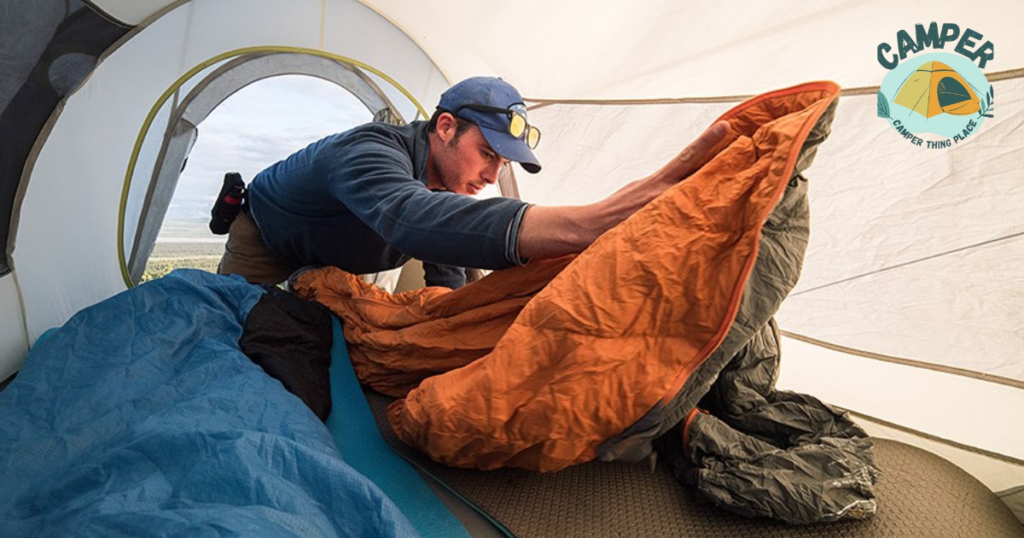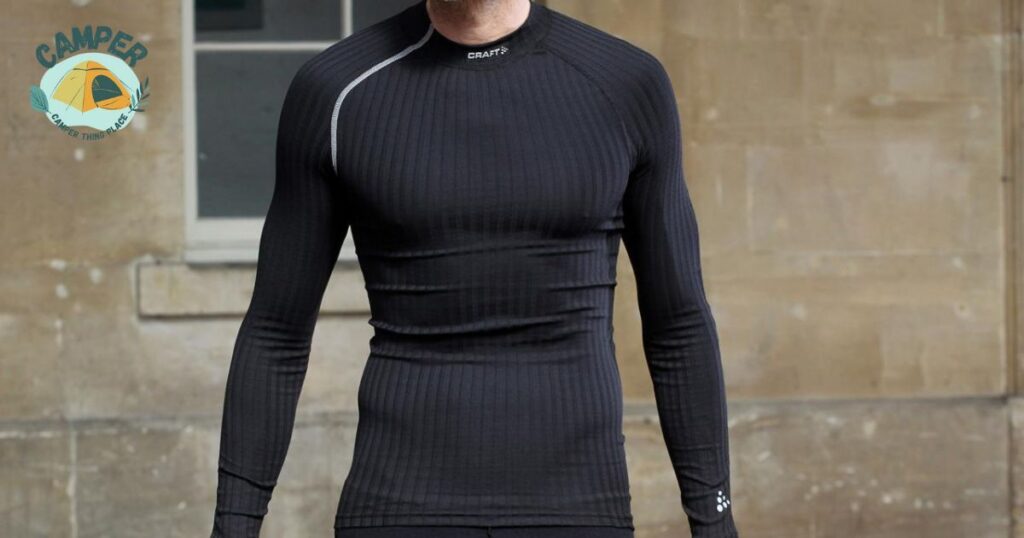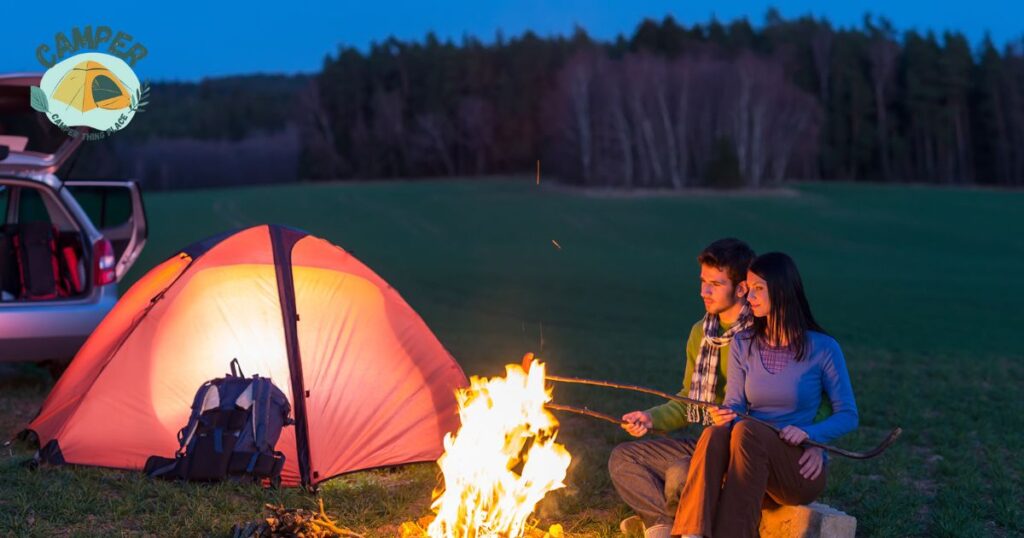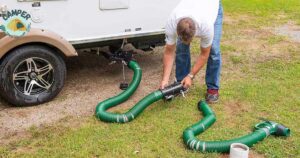Staying warm in a tent during cold nights is crucial for a comfortable camping experience. Use a high-quality sleeping bag designed for cold weather to retain body heat. Wear layers, including thermal clothing, and insulate the tent floor with a thick sleeping pad to prevent heat loss to the ground.
When it is cold outside, your tent becomes a cozy haven, shielding you from the chill. It’s like a warm home in the wilderness, keeping you snug and happy. Here is a question how to stay warm in a tent on cold nights. So, when the temperature drops, step into your tent. Your secret to staying warm and enjoying the night outdoors
To stay warm in a tent on cold nights, choose a sleeping bag with a lower temperature rating. Use a quality sleeping pad for insulation, dress in layers, and wear a hat. Consider bringing a hot water bottle or heated rocks, and ventilate the tent to minimize condensation. Eating a hot meal before bedtime can also help generate internal heat for a cozy night’s sleep.
Understanding the Basics
Staying warm in cold weather is important. Wear layers to trap heat. Start with a thermal shirt, add a sweater, and wear a coat. Don’t forget gloves, a hat, and warm socks. Keep your feet dry to stay warm. Drink hot beverages to maintain body temperature. Find shelter when it’s extremely cold. Understanding these basics helps you stay cozy in chilly conditions.
Importance of planning for cold weather during a camping trip
Planning for cold weather on a camping trip is crucial. Cold temperatures can be challenging and even dangerous. Acceptable preparation ensures a safe and enjoyable experience. Pack warm clothing, including layers, hats, and gloves.
Bring a quality sleeping bag rated for low temperatures. Set up a reliable shelter to shield against the cold wind. Plan hot meals and drinks to stay warm from the inside. Being prepared for cold weather enhances comfort and reduces the risk of cold-related issues, making your camping adventure more enjoyable.
Overview of essential camping gear for staying warm
Essential camping gear for staying warm includes a quality sleeping bag with an appropriate temperature rating, layered clothing for insulation, a weather-resistant tent, an insulated sleeping pad or air mattress, and portable stoves or cookware for warm meals.
Accessories like hand warmers and heated blankets add extra comfort. Careful selection and packing of these items ensure a cozy and enjoyable camping experience, even in cold weather.
Choosing the Right Tent To Stay Warm
When camping in cold weather, selecting the right tent is important. Look for a tent with a sturdy, wind-resistant design to survive chilly conditions. Insulated tents with proper ventilation help keep warmth inside while preventing condensation.
Choose a tent with a low-profile shape to minimize exposure to strong winds. Check the temperature rating of the tent to ensure it suits the expected cold conditions. Additionally, a durable rainfly adds an extra layer of protection against snow or rain.
Consider a tent with a vestibule for storing gear, keeping the interior organized, and preventing cold drafts. Lastly, prioritize ease of setup, as assembling a tent in freezing temperatures can be challenging.
Selection of a suitable tent for cold-weather camping
Select a tent designed for cold weather with sturdy poles and a low-profile design to stay warm in cold weather. Ensure proper insulation, and ventilation, and check the temperature rating. A durable rainfly is essential for protection against snow or rain.
Look for a tent with a vestibule to organize gear and block cold drafts. Prioritize easy setup to tackle freezing temperatures efficiently. The right tent enhances comfort during cold-weather camping.
Considerations for tent insulation and material

Select a tent with good insulation for warmth in various weather conditions. Opt for durable materials like ripstop nylon or polyester to withstand wear and tear. Choose a double-wall design for effective condensation management.
Prioritize a waterproof rainfly made of quality materials to stay dry in rain or snow. Check the tent’s seams, zippers, and floor for additional weather resistance. Investing in proper insulation and quality materials ensures a comfortable and reliable camping experience.
Tips for proper tent setup to retain heat
Here are some tips about the proper setup to retain heat in your camps in cold nights
| Tips | Description |
| Choose a Sheltered Location | Select a campsite shielded from prevailing winds or use natural barriers like trees or rocks to reduce heat loss. This helps maintain a more comfortable temperature inside the tent. |
| Use a Ground Tarp | Lay a ground tarp under the tent to act as an additional barrier against the cold ground. This prevents heat from being conducted away from your sleeping area and adds an extra layer of insulation. |
| Properly Staked Rainfly | Ensure the rainfly is securely staked close to the tent, leaving minimal gaps. This helps block drafts and creates a barrier against wind, keeping the interior warmer. |
| Ventilation Management | Adjust tent vents to balance airflow. Proper ventilation prevents condensation inside the tent while maintaining a comfortable temperature. Adjust vents based on weather conditions to avoid excessive cold air intake. |
| Tighten Tent Guy Lines | Keep tent guy lines taut and properly staked. This provides stability in windy conditions, preventing flapping that can let cold air seep into the tent. A stable tent structure helps retain warmth. |
| Invest in a Quality Sleeping Bag | Choose a sleeping bag with adequate insulation suitable for low temperatures. A good sleeping bag is crucial for retaining personal warmth, and its insulation properties contribute significantly to overall comfort. |
Clothing Choices To Stay Warm On Cold Nights

Start with a warm base layer, like thermal underwear, to keep your body insulated. Add layers such as a fleece or down jacket for extra warmth. Don’t forget waterproof outer layers to shield against rain or snow.
Opt for moisture-wicking fabrics to keep sweat away and prevent feeling damp. A good pair of insulated and waterproof boots will keep your feet warm and dry. Pack a beanie and gloves to protect your head and hands from the cold. Consider bringing a neck gaiter or scarf for added warmth.
Lastly, choose a good sleeping bag rated for low temperatures and wear a hat to retain body heat while sleeping. Remember, proper clothing makes camping on cold nights more enjoyable and safe.
Importance of appropriate clothing for cold nights
For maintaining body heat and preventing hypothermia, clean-rv-awning insulated layers and thermal materials help keep you warm and comfortable in chilly conditions. Proper attire acts as a barrier against cold winds and precipitation, ensuring you stay dry.
It not only enhances comfort but also contributes to safety, reducing the risk of cold-related ailments. Choosing the right clothing allows you to fully enjoy the outdoor experience without the discomfort of extreme cold. In summary, dressing appropriately for cold nights is essential for both comfort and well-being in challenging weather.
Strategic dressing for optimal warmth
- Begin with a moisture-wicking base layer to manage sweat.
- Add insulating layers like fleece or down for heat retention.
- Utilize outer layers that are both waterproof and windproof.
- Protect extremities with insulated, waterproof boots, gloves, and a hat.
- Adjust layers according to activity level and changing weather conditions.
- Employ a strategic approach to ensure warmth, dryness, and comfort in diverse cold environments.
Base Layer

Choosing the right base layer for cold nights during camping is crucial. Start with thermal underwear to trap and retain body heat. Look for materials like merino wool or synthetic fabrics for effective insulation.
A snug fit is essential to prevent heat loss. Moisture-wicking properties are key to keeping you dry, as dampness can make you feel much colder. Prioritize comfort to ensure a good night’s sleep in chilly conditions.
Layering is the key, so consider adding a fleece or insulated jacket on top for extra warmth. Don’t forget a hat and warm socks to complete your cold-weather camping ensemble.
Choosing the right material
When selecting materials for a camping base layer in cold weather, prioritize insulation and moisture-wicking properties. Opt for fabrics like merino wool or high-quality synthetic materials that effectively trap heat while wicking away sweat.
A balance between warmth and breathability is essential for comfort. Additionally, consider the durability and weight of the material, as these factors play a role in the overall functionality of the base layer during cold nights in the outdoors.
Importance of moisture-wicking
Moisture-wicking is crucial in a camping base layer for several reasons. Firstly, it helps keep the body dry by quickly drawing sweat away from the skin to the outer surface of the fabric. This is vital in cold weather because dampness can significantly increase the perception of cold and lead to discomfort.
Additionally, moisture-wicking fabrics contribute to temperature regulation by preventing the accumulation of sweat, which can make the body feel colder when it evaporates. This feature not only enhances comfort during outdoor activities.
It also reduces the risk of hypothermia in chilly conditions. Choosing a base layer with effective moisture-wicking properties is thus essential for maintaining warmth and overall well-being in cold nights.
Layering Techniques
Winter camping requires smart layering for warmth. Start with a moisture-wicking base layer to keep sweat away. Add an insulating layer like fleece for trapping heat. A waterproof and windproof outer layer shields against the cold.
Don’t forget a hat and gloves for extra warmth. Adjust layers as needed to stay comfortable. Proper layering keeps you cozy during chilly winter adventures.
Insulating layers
For staying warm in cold weather, insulating layers play an important role. These layers trap and retain body heat, providing the necessary insulation to keep you comfortable. Materials like fleece, down, or synthetic fibers work well for insulation.
Adding insulating layers between your base and outer layers creates a thermal barrier, preventing heat loss. Remember, the key to effective insulation is layering, ensuring you’re prepared for the varying temperatures of winter conditions.
Outer layers for protection against elements
Outer layers are your shield against the harsh elements during winter camping. Opt for a waterproof and windproof jacket to keep rain and snow at bay. Look for features like sealed seams and adjustable cuffs for added protection.
A durable outer layer also acts as a barrier against chilly winds, preventing heat loss. Choose breathable materials to avoid moisture buildup inside. Investing in a reliable outer layer ensures you stay dry and comfortable, ready to face whatever the winter weather throws your way.
Maximizing Body Heat
When camping on chilly nights, campers need to stay warm. Maximizing body heat is key. Start by dressing in layers. Wear thermal underwear and add insulated clothing. A hat keeps heat from escaping through the head.
Use a sleeping bag designed for low temperatures. Eat high-energy snacks before bed to fuel your body. Keep your tent well-sealed to block drafts. Place a reflective blanket under your sleeping bag to bounce heat back.
Stay active to generate warmth. Consider using a hot water bottle or heat pack in your sleeping bag. By following these tips, campers can make the most of their body heat and enjoy cozy nights in the cold outdoors.
Understanding the role of body heat in staying warm
Body heat plays an important role in staying warm, especially in cold environments. The human body constantly produces heat through metabolic processes. To retain warmth, it’s important to understand how to manage and maximize this internal heat.
Clothing choices impact heat retention; wearing layers traps warmth close to the body. Additionally, headwear prevents heat loss from the head, a significant source of dispersion. In cold conditions, the body tends to prioritize vital organs, so extremities like hands and feet may feel colder.
Proper insulation, through clothing and shelter, helps maintain a comfortable body temperature. Understanding the dynamics of body heat is essential for effective strategies to stay warm in various outdoor situations.
Tips for retaining body heat inside the tent

Retaining body heat inside the tent is crucial for staying warm during cold nights. Here are some tips to help maximize warmth:
Quality Sleeping Bag: Invest in a high-quality sleeping bag designed for cold temperatures to stay warm. Look for one with proper insulation to retain body heat effectively.
Insulated Sleeping Pad: Place an insulated sleeping pad under your sleeping bag. This provides a barrier between your body and the cold ground, preventing heat loss.
Layered Clothing: Wear layers of clothing, including thermal or moisture-wicking base layers, to trap warmth close to your body. Stay warm by adding or removing layers as needed to regulate your body temperature.
Proper Ventilation: While it may seem counterintuitive, maintaining proper ventilation in the tent is essential. Condensation can make things damp and cold, so ensure there’s enough airflow without creating drafts.
Seal Tent Gaps: Check your tent for any gaps or openings that might allow cold air to enter. Seal these gaps with additional layers or use a draft stopper to keep the warmth inside.
Use a Tent Heater (if safe): In some cases, a small, safe tent heater can help maintain a comfortable temperature. Ensure it’s designed for indoor use and follow all safety precautions.
Hot Water Bottles or Heat Packs: Place hot water bottles or heat packs inside your sleeping bag before bedtime. They provide extra warmth during the night.
Eat High-Energy Snacks: Consuming high-energy snacks before bedtime can help fuel your body, generating additional heat as your metabolism processes the food.
Stay Dry: Moisture can make you feel colder. Make sure your clothing and sleeping bag stays dry, as wet fabric conducts heat away from your body.
Position Yourself Strategically: If you’re sharing a tent, position yourself close to your camping partners to share body heat. Consider sleeping in a fetal position to minimize heat loss.
By combining these tips, you can create a cozy and warm environment inside your tent, ensuring a more comfortable camping experience in cold weather.
Moisture Management
Keeping dry is crucial when camping on cold nights. Moisture can make you feel colder, so it’s essential to manage it effectively. Use a waterproof tent to prevent rain or snow from getting inside. Invest in a quality sleeping bag with water-resistant material to stay warm and dry.
Wear moisture-wicking layers to keep sweat away from your body. Avoid breathing inside your sleeping bag to reduce condensation. By focusing on moisture management, you’ll ensure a more comfortable and enjoyable camping experience during chilly nights.
The impact of moisture on body heat retention
Moisture significantly impacts body heat retention, especially in cold weather. Wet clothing or bedding conducts heat away faster than dry materials, increasing the risk of hypothermia and hampering the body’s ability to maintain warmth.
The presence of moisture on the skin or in clothing creates a chilling effect, making individuals feel colder. Proper moisture management is crucial during cold-weather activities, as it enhances thermal comfort.
Using waterproof and breathable materials, staying dry, and incorporating moisture-wicking layers are essential strategies to prevent heat loss and ensure warmth in challenging conditions.
Tips for managing moisture inside the tent
Choose a waterproof tent with proper ventilation to minimize condensation. Keep wet gear outside and use absorbent materials inside the tent. Avoid cooking inside to reduce humidity, and opt for moisture-wicking sleeping gear for added comfort. These tips help manage moisture, ensuring a dry and cozy camping experience.
- Ventilation strategies: Open windows and doors to allow fresh air circulation. Use exhaust fans in moisture-prone areas like kitchens and bathrooms. Install vents for improved airflow, reducing humidity indoors. Employ cross-ventilation by strategically placing openings on opposite sides of the space.
- Proper drying of wet clothing and gear: To properly dry wet clothing and gear, hang them in a well-ventilated area or use a drying rack. Avoid direct sunlight for delicate fabrics to prevent damage. Turn clothing inside out to speed up drying, and shake off excess water before hanging. Ensure proper airflow around the items to expedite the drying process, promoting freshness and preventing mildew.
Insulation Strategies
When camping on chilly nights, insulation is vital for staying warm. Start by choosing a quality sleeping bag designed for cold weather to stay warm. Look for bags with lower temperature ratings. Use a sleeping pad beneath your sleeping bag to insulate yourself from the cold ground.
Layer your clothing to trap body heat – wear thermal layers and a hat. Seal any gaps in your tent to keep drafts out. Consider using a four-season tent designed for colder temperatures.
Lastly, pack a hot water bottle to keep warm inside your sleeping bag. These simple insulation strategies will help you enjoy cozy and comfortable nights while camping in the cold.
Additional insulation techniques for cold nights
Increase insulation on cold nights by using a space blanket or emergency bivy. Place a tarp under your tent to minimize heat loss to the ground. Wear insulated, waterproof boots for warmth and dryness.
Opt for a tent with a rainfly to block cold winds. Choose a campsite with natural windbreaks, like trees or rocks. Carry extra layers to adjust insulation as temperatures change.
Use of thermal blankets or emergency blankets
Thermal blankets, also known as emergency blankets, are essential to stay warm during cold nights. These lightweight and compact blankets are designed to reflect and retain body heat, providing an additional layer of warmth.
In camping scenarios, placing a thermal blanket inside your sleeping bag or using it as a barrier between you and the cold ground can significantly improve insulation. Their reflective surface helps minimize heat loss.
Making them valuable tools to stay warm in chilly conditions. Always include a thermal blanket in your camping gear to ensure a more comfortable and insulated experience during colder nights.
Creating a barrier against the cold ground
To create an effective barrier against the cold ground during camping. Use a combination of strategies. Start by placing a durable and insulating ground pad or sleeping pad underneath your sleeping bag.
This helps prevent heat loss to the ground and provides a cushioned layer for comfort. Additionally, consider laying a thermal or reflective blanket between the sleeping pad and the tent floor to further minimize heat transfer.
Choosing a campsite with natural insulation, such as dry leaves or pine needles, can add an extra layer between you and the cold ground. Combining these measures will create a reliable barrier, keeping you warmer and more comfortable during chilly nights in the great outdoors.
Campfire Considerations

When camping on cold nights, remember to dress warmly. Wear layers to stay cozy by the campfire. Bring a good-quality sleeping bag designed for low temperatures. Choose a suitable campsite with protection from the wind.
Gather enough firewood before it gets dark. Keep the fire manageable for safety. Bring hot beverages to stay warm from the inside. Pack insulated gloves and a hat. Be mindful of sparks and embers near your tent.
Safe and effective use of a campfire for warmth
Using a campfire for warmth is enjoyable, but safety is crucial. Start by choosing a safe location away from flammable materials. Clear a space and create a fire pit. Keep a bucket of water or a fire extinguisher nearby for emergencies.
Use dry and seasoned wood to minimize smoke. Build the fire slowly and avoid using accelerants. Keep the fire at a manageable size to prevent sparks. Never leave the campfire unattended, and fully extinguish it before sleeping.
Use a spark arrestor if possible. Dress in layers to avoid getting too close to the flames. Enjoy the warmth responsibly for a safe and cozy camping experience.
Choosing the right firewood
Choose dry hardwood like oak or maple for a steady campfire. Avoid green or wet wood to reduce smoke. Collect wood from the ground, not live trees. Plan ahead and gather enough firewood before nightfall. Prioritize seasoned wood for efficient burning. Follow these tips for a safe and enjoyable camping fire.
Campfire safety tips
Here are some tips for a safe campfire
- Pick a spot away from flammable materials and overhanging branches.
- Remove leaves, dry grass, and other combustibles around the fire pit.
- Keep a bucket of water, a hose, or a fire extinguisher within reach.
- Dig a pit and surround it with rocks to contain the fire.
- Dry, seasoned wood burns efficiently with less smoke.
- Maintain a moderate fire size to prevent sparks and ensure easy control.
- Always stay with the fire and fully extinguish it before leaving.
Follow these tips for a safe and enjoyable campfire experience.
Frequently Asked Questions
Can you sleep in a tent on cold nights?
Yes, you can sleep in a tent in the cold, but make sure to use a warm sleeping bag and dress in layers to stay comfortable.
How can I keep my tent warm without a heater?
To keep your tent warm without a heater, use a high-quality sleeping bag, or insulating sleeping pad, wear layers, seal any drafts, and choose a sheltered campsite.
How do you heat a tent all night?
Keep warm in a tent all night by using a quality sleeping bag, wearing layers, insulating the floor, and using a safe tent heater or hot water bottles.
Are tents good for cold weather?
Yes, tents can be suitable for cold weather when equipped with proper insulation, a warm sleeping bag, and layers to stay comfortable and warm.
Final Thoughts
To Stay warm in a tent on a cold night is essential for a comfortable camping experience. By using the right gear, such as a quality sleeping bag, insulated sleeping pad, and appropriate clothing, you can create a cozy and insulated sleeping environment.
Employing simple techniques like staying dry, eating warm meals, and insulating the tent floor can further enhance warmth. So here we inform you all about how to stay warm in a tent in a cold night. Remember, planning and being prepared are key to enjoying chilly outdoor nights without sacrificing comfort. Stay warm and enjoy your camping adventures.

Jackson Ray, a seasoned blogger with a decade of experience, is the creative mind behind “camperthingsplace.com.” Explore his wealth of insights and passion for camping through engaging content on the website.











